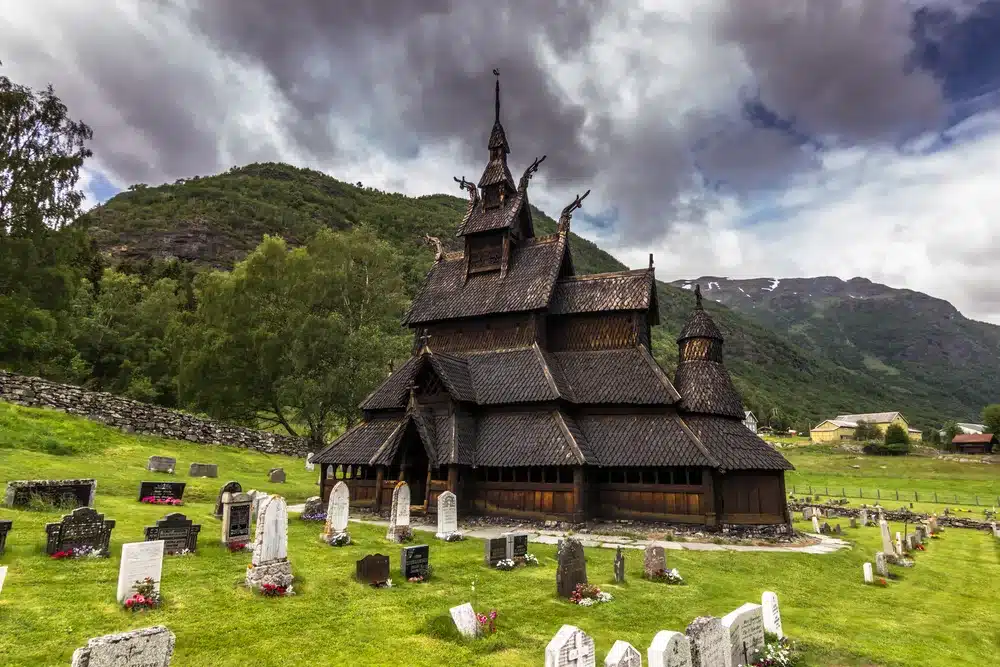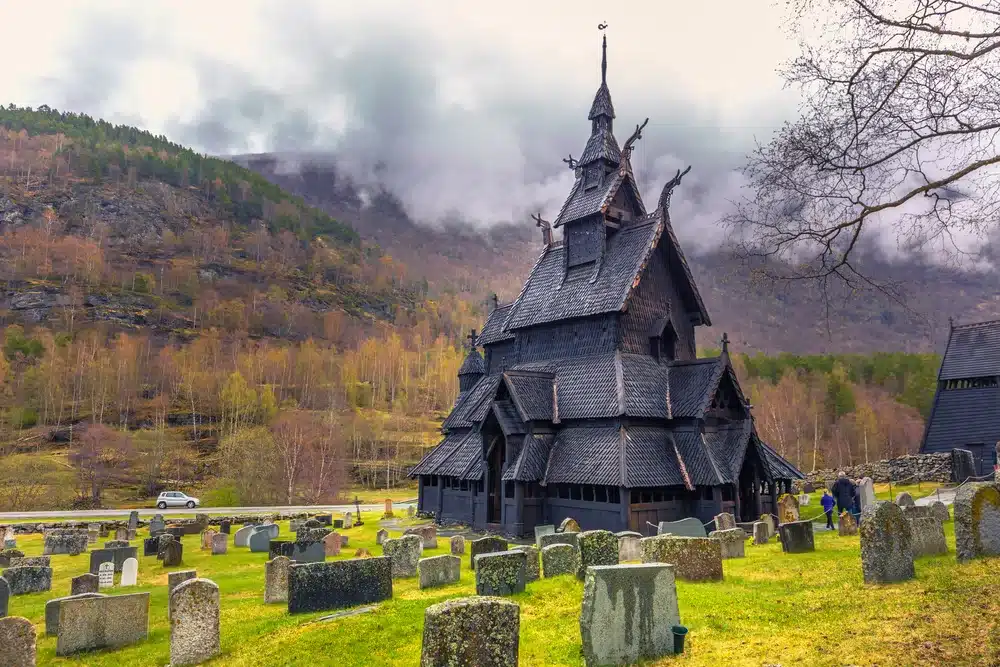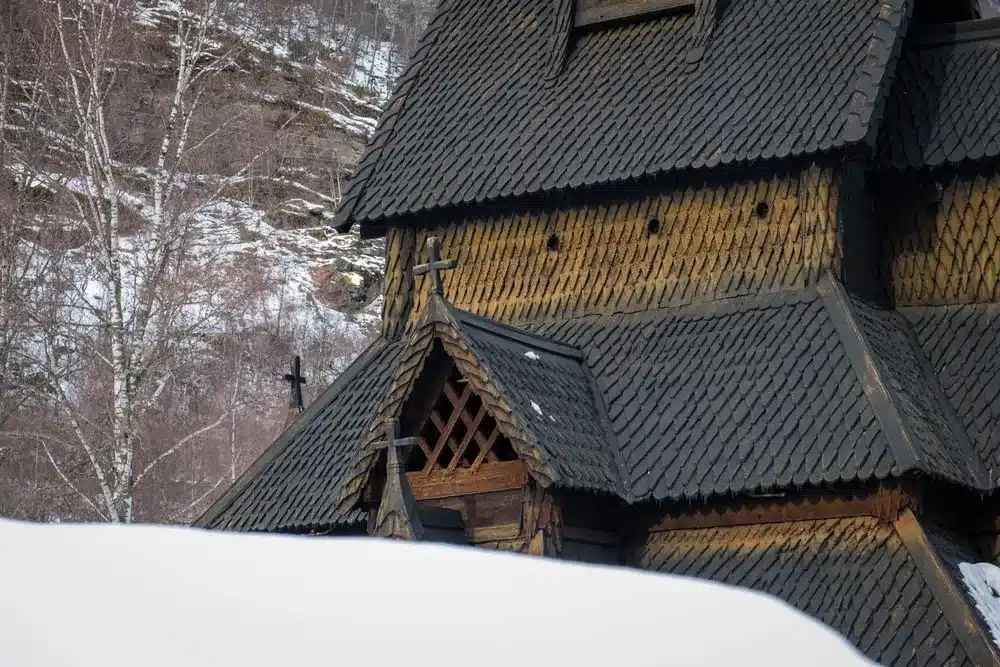
With its rich cultural and historical tapestry, Norway has many architectural gems that testify to its past. Among these treasures, the Borgund Stave Church holds a special place. Nestled in the picturesque Lærdal Valley, this stave church is a captivating representation of Norway’s architectural heritage.
Read about the 5 most famous Norwegian Fjords
We will give you the following 5 facts when exploring the Borgund Stave Church:
1. What is a stave church, and why is it important to Norway’s architectural heritage?

A stave church is a medieval wooden church characterised by its post-and-beam construction using timber (staves) as the primary structural elements. Stave churches are typically found in parts of Northern Europe, with Norway being one of the countries where they are most prevalent. They are significant to Norway’s architectural heritage for several reasons:
Historical Significance
Stave churches have a long history in Norway, dating back to the medieval period, with some of the earliest examples built in the 12th century. They represent a crucial part of Norway’s architectural heritage, reflecting its cultural and religious history.
Unique Architectural Style
One of the most essential things that Stave churches are known for is their distinctive architectural style. They often feature intricate wood carvings on doorways, portals, and other structural elements. The design of stave churches incorporates Christian and Norse mythology elements, showcasing the cultural and religious fusion of the time.
Preservation of Tradition
Stave churches are living examples of traditional Norwegian architecture. They have been preserved and maintained over the centuries, serving as a testament to the craftsmanship and construction techniques of the past.
Cultural Symbolism
Symbolising Norway’s transition from paganism to Christianity, incorporating elements like dragon-headed roofs, reminiscent of Norse mythology, into Christian churches reflects a deliberate effort to adapt and integrate traditional beliefs into the emerging faith. This intentional blending of cultural elements signifies Norway’s commitment to harmonising longstanding beliefs with the tenets of the new religion.
Tourist Attractions
Many stave churches, including the Borgund Stave Church, have become popular tourist attractions, drawing visitors worldwide. These churches provide a glimpse into Norway’s past and offer an opportunity to appreciate the country’s rich cultural and architectural heritage.
National Identity
Stave churches contribute to Norway’s sense of national identity and cultural pride. Literature, art, and folklore often depict them as iconic symbols of the nation’s heritage.
Preservation Efforts
Norway has made significant efforts to preserve its stave churches. Restoration and maintenance initiatives ensure that these architectural treasures stand for future generations to appreciate.
In summary, stave churches are essential to Norway’s architectural heritage due to their historical significance, unique architectural style, role in preserving tradition, cultural symbolism, status as tourist attractions, contribution to national identity, and ongoing preservation efforts. These churches are architectural marvels and symbols of Norway’s cultural and religious evolution.
Riding the Flåm Railway: A scenic Norwegian adventure
2. What is the history of Borgund Stave Church?

Borgund Stave Church, believed to have been built around 1180 and dedicated to the Apostle Andrew, embodies medieval Norwegian wooden architecture. Its unique construction, featuring intricate wooden carvings, has made it one of the most well-preserved stave churches in the country.
Key Features of Borgund Stave Church
Stave Construction
“Stave church” is derived from using staves or wooden posts. Borgund exemplifies this style with 32 staves supporting the structure.
Wooden Carvings

The Borgund Stave Church is adorned with astonishing wooden carvings depicting motifs from Norse mythology and Christian symbolism, showcasing the fusion of old Norse and Christian traditions.
Triple Nave Design
The Borgund Stave Church`s triple nave design is a hallmark of stave churches, giving it a unique and imposing appearance.
3. What is the significance of the dragon-headed gables?

The dragon-headed gables, often found in stave churches like the Borgund Stave Church, hold historical and cultural significance. Here’s why they are essential:
Pagan Origins
The dragon heads have pagan origins and are believed to have been incorporated into Norwegian stave churches to blend Norse mythology with Christian symbolism. In Norse mythology, dragons were powerful and mythical creatures associated with protection and strength. Combining these elements into Christian churches allowed a smoother transition from paganism to Christianity in Norway.
Guardian Symbolism
The dragon heads are often seen as protective guardians. Culturally, they symbolise protection for the church against natural and supernatural evil forces. This was particularly important in Norway’s harsh and often unpredictable climate.
Architectural Aesthetics
The dragon heads also serve an architectural purpose. They add an ornamental and distinctive feature to the church’s design, contributing to its uniqueness and visual appeal. These intricately carved dragon heads are a testament to the skilled craftsmanship of the time.
Historical Preservation
The presence of dragon-headed gables in stave churches like Borgund highlights the preservation of historical and cultural elements. These elements offer insight into the religious and cultural practices of the past and contribute to the sense of timelessness and continuity in Norwegian heritage.
In summary, the dragon-headed gables in stave churches like the Borgund Stave Church have a multifaceted significance. They blend elements of Norse mythology with Christian symbolism, provide protection and guardianship, enhance the church’s architectural aesthetics, and contribute to preserving historical and cultural heritage. These elements showcase the complexity and richness of Norway’s architectural and cultural history.
Get 8 essential tips for exploring Jotunheimen National Park
4. How do you explore the surroundings of Borgund Stav Church?

Exploring the Borgund Stave Church offers a glimpse into history and a chance to appreciate the stunning Norwegian landscape. The Lærdal Valley’s lush greenery, mountains, and serene surroundings provide an idyllic backdrop for this ancient masterpiece.
Practical Information for Visitors
- Opening Hours: The church is open to visitors in the summer, usually from mid-April to mid-October.
- Admission: Adults have a nominal fee, while children under 16 can enter for a smaller fee.
- Guided Tours: Knowledgeable guides are often available to enhance your experience by providing insights into the church’s history and architectural significance.
Please take a look at the admission fee and opening hours here.
5. Preserving Norway’s Heritage

Borgund Stave Church’s enduring presence is a testament to Norway’s commitment to preserving its cultural and architectural heritage. It offers a window into a bygone era and a chance to appreciate past craftsmanship.
In conclusion, exploring the Borgund Stave Church is a journey back in time and an opportunity to witness Norway’s medieval history’s artistic and architectural brilliance. With its intricate carvings, triple nave design, and breathtaking surroundings, this stave church is a must-visit destination for history enthusiasts and those seeking to immerse themselves in Norway’s cultural heritage. Take the chance to explore this captivating piece of Norway’s past during your travels.
Read more about the Sognefjord and how to get there



